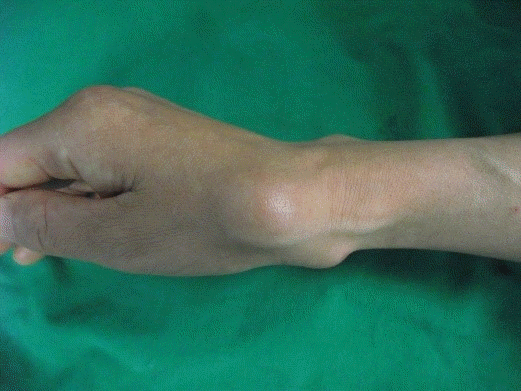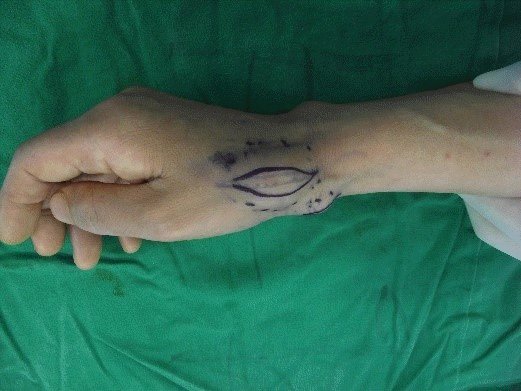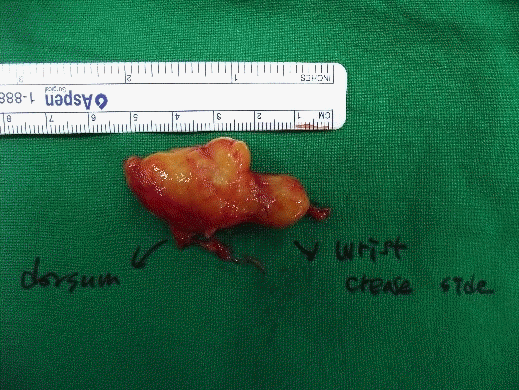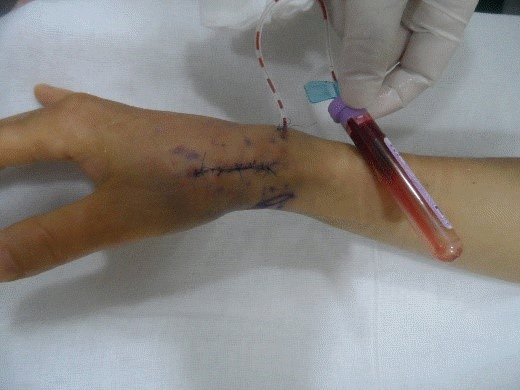Abstract
A variety of benign and malignant neoplasms can develop in the hand, originating from skin, adipose tissue, tendons, muscles, nerves, and bones. However, most cases are benign; therefore, observation is recommended if they are small, painless and do not cause limitation of motion. When symptoms are present or a lesion is larger than 5 cm in the long axis, an excisional biopsy is required to relieve symptoms and exclude malignancy. Lipomas of the hand are quite rare and do not generally cause symptoms. Lipomas of the hand that do present with symptoms are usually giant (larger than 5 cm in diameter) or located in a deeper layer, compressing the nearby nerves and vessels. We report a rare case of a non-giant superficial lipoma of the wrist that resembled two separate masses and caused pain, limitation of motion, and neurological symptoms.
Most masses that develop on the hand and wrist are benign. Ganglion cysts, accounting for about 60% of the masses on the hand and wrist, are the most common, followed by giant cell tumors, lipomas, epidermal inclusion cysts, Dupuytren’s contractures, and glomus tumors [1,2]. The differential diagnosis is initially based on the clinical appearance (e.g., anatomical location, size, morphology, and texture) [1,3]. Ultrasonography is the preferred imaging modality by surgeons for its cheapness and ability to assess surrounding soft tissue structures, such as neurovascular bundles [4]. For small masses, with no pain and no limitation of movement, follow-up monitoring is usual. However, if a mass is accompanied by symptoms or is larger than 5 cm, surgical excision should be considered, and the precise diagnosis needs to be confirmed by a pathologist [3].
Here, we report a case of a relatively small soft tissue mass, accompanied by pain, limitation of movement, and neurological symptoms, which initially resembled two separate masses on physical examination but was later confirmed to be a single, connected lipoma.
A 47-year-old woman presented with two apparently separate masses on her right wrist. She reported that both masses first appeared about 2 years ago, without any trauma (Fig. 1). The larger of the two masses was on the radial dorsal aspect, and the smaller mass was on the wrist crease. She took only antihypertensive drugs and stated that she had not undergone any type of surgery before. There was initially no pain, and the size of the masses on palpation was under 1 cm each, but the masses had grown gradually over the last few months. She complained of pain and restricted movement of the wrist, as well as neurological symptoms such as numbness and a tingling sensation in the digits, especially on the thumb and index finger. Palmar flexion of wrist joint induced tingling sensation in digits and dorsiflexion was limited due to size of the mass. There was no similar symptom on the opposite hand. The masses were soft on palpation with no tenderness and well-defined margins. The overlying skin was stretched but normal. The vein just beneath the skin was bulged out, showing possible compression of nearby vessels (Fig. 1). A wrist plain radiograph showed a diffuse soft tissue shadow. Ultrasonography of the lesion was carried out, showing two different well-defined hyperechoic fatty masses of similar architecture. There was no evidence of connection (Fig. 2). Surgery was planned under a brachial plexus block using tourniquet hemostasis. After designing an incision line in an elliptical shape covering both masses on the radial dorsal aspect and on the wrist crease (Fig. 3), dissection was performed down to the fascia. When we tried pulling the mass with forceps, the mass on the wrist crease also moved, showing that the two masses were connected (Fig. 4). The gross appearance was fatty, yellowish, and well-capsulated; the mass on the radial dorsal aspect measured 3.0×2.0 cm2, while that on the wrist crease measured 1.5×1.2 cm2 (Fig. 5). After complete excision of the mass, we placed a vacuum-assisted drain to prevent a hematoma formation (Fig. 6). After skin suture, the excised mass was biopsied.
No complications occurred following total excision, and the postoperative period was uneventful. About 1.5 mL of fluid was drained until postoperative day 2, and the drain was removed on postoperative day 3. The stitches were fully removed on postoperative day 9. Histology reports confirmed a simple lipoma consisting of well-differentiated mature adipose tissue, with no malignant potential. Right after operation, wrist function was normal and the neuropathy, resulting from pressure by the mass on the nerve, was markedly improved. Since the incision was limited to the dorsum of the hand, it was unable to grossly confirm the compression of nearby neurovascular bundles. However, from the fact that patient’s numbness confined to the radial nerve innervation territory subsided immediately, authors assumed that the bridge between two masses must have compressed the superficial branch of the radial nerve.
Written informed consent was obtained from the patient for the publication of this report including all clinical images.
The clinical appearance of a soft tissue mass of the hand and wrist provides information enabling a tentative or approximate diagnosis [3]. Its location and symptoms may help a surgeon to surmise the most likely identity of the disease, and the importance of a thorough physical examination evaluating the characteristics of the mass (e.g., hardness, movability, and tenderness) should not be underestimated. Magnetic resonance imaging is the best modality for evaluating soft tissue tumors [5,6], but ultrasonography is the first imaging modality chosen by most surgeons because of its availability, accessibility, and affordability [3,4]. Standard X-rays may help diagnose bone-related lesions or calcifications. When a general impression of the mass is present and the patient has no symptoms, observation can be tried first since soft tissue masses of the hand and wrist are usually benign [1]. If the mass shows atypical manifestations or causes symptoms such as pain and neuropathy, complete excision should be considered to relieve symptoms and rule out malignancy [3]. A fast-growing mass with symptoms has the potential of malignancy [7].
The most common type of soft tissue tumor of the hand and wrist is a ganglion cyst [7]. Ganglion cysts are mostly found in women in their 20s to 40s, and they usually occur on the dorsal aspect of the wrist, along the tendons or joints [1]. Since they are filled with thick fluid, they can be diagnosed with a simple transillumination test in an office with small light or through the aspiration of thick fluid [3,7]
Lipoma is a common type of benign neoplasm discovered in up to 2% of the population that can occur almost anywhere in the body [3,8]. However, lipomas in the distal extremities are extremely rare, accounting for fewer than 1% of lipoma cases [4,6,8]. Lipomas of the hand usually occur in the subcutaneous layer [3,9], probably due to the thick mid-palmar fascia, but they are also found in the intermuscular, intramuscular, and parosteal layers [5,7]. Cysts typically appear as painless, well-circumscribed, and movable masses, and these findings may help in the diagnosis. Lipomas of the hand often appear on the thenar or hypothenar eminence regions, with a diameter smaller than 5 cm [7]. If a lipoma is present on the palm, it may cause symptoms, such as difficulty gripping or limited motion on the digits, since even a small lipoma can press upon the intrinsic muscles [8]. Furthermore, if a lipoma occurs in limited spaces such as the carpal tunnel and Guyon’s canal, it may cause additional symptoms by pressing upon nearby nerves; for instance, patients may experience a tingling sensation and numbness, just as in carpal tunnel syndrome [1,4,6,8]. In the hand and wrist, lipomas appear radiolucent on simple radiographs, called “water-clear density.” Ultrasonography is also a dynamic tool for locating the mass, differentiating it from surrounding nerves and tendons, and determining the severity of compression [8]. Symptomless small masses assumed to be simple lipomas can be observed. In giant lipomas, defined as larger than 5 cm in diameter [4,5], excisional biopsy is recommended because these lesions have a higher chance of being liposarcoma and the symptoms mentioned above may be more common due to the higher likelihood of compression neuropathy [5,8,10]. Monobloc resection with careful dissection is the treatment of choice to prevent recurrence and iatrogenic injuries, considering the intricate anatomy of the hand. Complications such as neural injuries should not be neglected in hand tumors. These complications depend on the duration and the severity of compression, which can lead to nerve degeneration. Recovery may be uncertain in cases of chronic compression; therefore, early management should be emphasized in patients with neurological symptoms [10].
When the authors first encountered this case, we first expected a ganglion cyst rather than a lipoma. The patient’s sex and age, as well as the location of the mass (dorsal side of the wrist), were very suspicious for a ganglion cyst. The physical examination also did not evidently show a lipoma either, as the masses were soft and slowly growing. Preoperative ultrasound exam missed the connection between both masses and we assumed that the examiner might have compressed the bridge, obscuring the mass from surrounding soft tissue. Nerve conduction study was recommended to the patient before surgery, but rejected for cost issues. During the operation, the authors discovered that the two apparent masses were a single mass connected by thinner bridge, surrounding the radial aspect of the wrist, pressing on the superficial branch of the radial nerve, which might have caused the patient’s numbness and tingling sensation. Superficial branch of the radial nerve is located slightly lateral to the radial artery, beneath the brachioradialis. It is a sensory nerve, consisting of medial and lateral branches. Authors assume that lateral branch, related to the sensory function of the radial dorsal thumb, must have been mainly decompressed in this case. There are a few reports of lipomas of the hand that caused symptoms due to their large size and location in the deep palmar space, which led to nerve compression [4-6,8,10]. Panse et al. [4] reported a horseshoe-shaped giant lipoma of the ulnar border of the distal forearm, encasing the entire distal ulna, causing similar symptoms to those in our case (numbness in the ulnar nerve territory). However, there has been no previous report of a case of a non-giant lipoma located superficially in the hand, causing neurological symptoms. Therefore, the authors present this rare case of a lipoma on the hand, smaller than 5 cm in diameter, which was located superficially in the subcutaneous layer and caused pain and neuropathy by surrounding the wrist. Based on our case, we suggest that hand surgeons should keep in mind that smaller benign soft tissue neoplasms on the hand can also cause symptoms by compression of nearby structures such as the nerves, arteries, and veins.
References
1. Teh J. Ultrasound of soft tissue masses of the hand. J Ultrason. 2012; 12:381–401.
2. Nadar MM, Bartoli CR, Kasdan ML. Lipomas of the hand: a review and 13 patient case series. Eplasty. 2010; 10:e66.
3. Fazilleau F, Williams T, Richou J, Sauleau V, Le Nen D. Median nerve compression in carpal tunnel caused by a giant lipoma. Case Rep Orthop. 2014; 2014:654934.
4. Panse N, Sahasrabudhe P, Chandanwale A, Joshi N. A rare case of horse shoe shaped lipoma of the upper extremity. World J Plast Surg. 2013; 2:41–3.
5. Clesham K, Galbraith JG, Ramasamy A, Karkuri A. Giant lipoma of the hand causing median nerve compression. BMJ Case Rep. 2017; 2017:bcr2017220056.
6. Papakostas T, Tsovilis AE, Pakos EE. Intramuscular lipoma of the thenar: a rare case. Arch Bone Jt Surg. 2016; 4:80–2.
7. Tellier B, Gabrian M, Jaquet JB. Carpal tunnel syndrome caused by a giant lipoma of the hand: a case report. Int J Surg Case Rep. 2021; 80:105647.
8. Mavrogenis AF, Panagopoulos GN, Angelini A, et al. Tumors of the hand. Eur J Orthop Surg Traumatol. 2017; 27:747–62.
9. Yadav SP, Jategaonkar PA, Haldar PJ. Giant hand lipoma revisited: report of a thenar lipoma & its literature review. J Hand Microsurg. 2013; 5:84–5.
10. Barreira M, Marques N, Campos V, Marques G, Gonçalves S, Stefanova Alves S. A giant hand lipoma as a rare cause of secondary carpal tunnel syndrome: a case report. Int J Surg Case Rep. 2020; 77:538–42.
Fig. 1.
Preoperative photograph. Two apparently different palpable masses were located on the right wrist; one on the radial dorsal aspect, and the other on the wrist crease.

Fig. 2.
Preoperative ultrasound images of (A) the radial dorsal aspect mass and (B) the wrist crease mass. The estimated lengths were 1.84 cm (A) and 1.23 cm (B) in the long axis.

Fig. 3.
Preoperative photograph. An elliptical incision line was drawn on the radial dorsal aspect of the wrist.





 PDF
PDF Citation
Citation Print
Print






 XML Download
XML Download